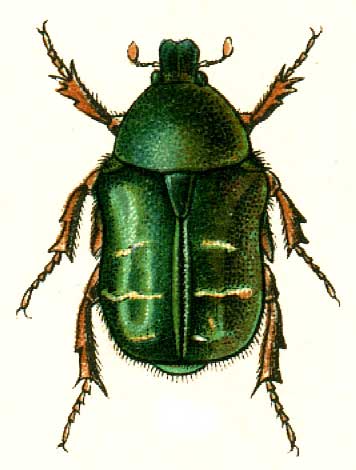
Cetonia aurata
Superregnum: Eukaryota
Cladus: Unikonta
Cladus: Opisthokonta
Cladus: Holozoa
Regnum: Animalia
Subregnum: Eumetazoa
Cladus: Bilateria
Cladus: Nephrozoa
Cladus: Protostomia
Cladus: Ecdysozoa
Cladus: Panarthropoda
Phylum: Arthropoda
Subphylum: Hexapoda
Classis: Insecta
Cladus: Dicondylia
Subclassis: Pterygota
Cladus: Metapterygota
Infraclassis: Neoptera
Cladus: Eumetabola
Cladus: Endopterygota
Superordo: Coleopterida
Ordo: Coleoptera
Subordo: Polyphaga
Infraordo: Scarabaeiformia
Superfamilia: Scarabaeoidea
Familia: Scarabaeidae
Subfamilia: Cetoniinae
Tribus: Cetoniini
Subtribus: Cetoniina
Genus: Cetonia
Species: Cetonia aurata
Subspecies: C. a. aurata – C. a. jingkelii – C. a. pallida – C. a. pisana – C. a. pokornyi – C. a. sicula – C. a. viridiventris
Name
Cetonia aurata (Linnaeus, 1761)
Original combination: Scarabaeus auratus
References
Linnaeus, C. 1758. Systema Naturae per regna tria naturæ, secundum classes, ordines, genera, species, cum characteribus, differentiis, synonymis, locis, Tomus I. Editio decima, reformata. Holmiæ: impensis direct. Laurentii Salvii. i–ii, 1–824 pp DOI: 10.5962/bhl.title.542: 352. Reference page.
Links
Korzunovich, P. 2004. Cetonia aurata (Linnaeus, 1758) - photos by P. Korzunovich. Beetles (Coleoptera) and coleopterists.
Vernacular names
العربية: جعل ذهبي
беларуская (тарашкевіца): Бронзаўка залацістая
беларуская: Бронзаўка залацістая
български: Обикновена златка
čeština: Zlatohlávek zlatý
dansk: Grøn guldbasse
Deutsch: Goldglänzender Rosenkäfer
English: Rose Chafer
Esperanto: Ora cetonio
eesti: Kuldpõrnikas
suomi: Kultakuoriainen
français: Cétoine dorée
magyar: Aranyos rózsabogár
Ido: Cetonio orea
italiano: Cetonia dorata
lietuvių: Paprastasis auksavabalis
Nederlands: Gouden tor
occitan: Manjaròsas
polski: Kruszczyca złotawka
русский: Золотистая бронзовка
slovenčina: Zlatoň obyčajný
српски / srpski: Буба-злата
svenska: Gräsgrön guldbagge
Türkçe: Gül böceği
中文: 金花金龟
Cetonia aurata, called the rose chafer or the green rose chafer, is a beetle, 20 millimetres (3⁄4 in) long, that has a metallic structurally coloured green and a distinct V-shaped scutellum. The scutellum is the small V-shaped area between the wing cases; it may show several small, irregular, white lines and marks. The underside of the beetle has a coppery colour, and its upper side is sometimes bronze, copper, violet, blue/black, or grey.
Cetonia aurata should not be confused with the North American rose chafer, Macrodactylus subspinosus, or with the rarely seen noble chafer, Gnorimus nobilis, which is very similar to the rose chafer. One way to identify Cetonia aurata is to look at its scutellum; on the noble chafer the scutellum is an equilateral triangle, but on the rose chafer it is an isosceles triangle.
Overview
Rose chafers are capable of fast flight; they fly with their wing cases down. They feed on pollen, nectar, and flowers, especially roses. They can be found among roses on warm sunny days from May until June or July, and occasionally as late as September. Rose chafers are found in southern and central Europe and in the southern part of the United Kingdom, where they sometimes seem to be very localized. They can also be found in South East Asia, in the countryside and outlying islands of Hong Kong. They are a beneficial saprophagous species (detritivores).
Life cycle
The larvae are C–shaped and have a firm, wrinkled, hairy body, a small head, and tiny legs. The larvae overwinter wherever they have been feeding, which may be in compost, manure, leaf mould, or rotting wood. They grow very quickly and will have moulted twice before the end of autumn. They have a two-year life cycle. They pupate in June or July. Some adult beetles may emerge in autumn, but the main emergence is in spring, when the beetles mate. After mating, the female beetles lay their eggs in decaying organic matter and then die.
Coloration
The metallic green coloration of the beetle is created structurally,[2] caused by the reflection of mostly circularly polarised light; like other scarabs this is left circularly polarised.[2] When viewed through a right circular polariser, the beetle appears to be colorless. There are also different colors besides the common green; there is also copper, grey and black. A lot of specimens have white speckles while some have very few or none at all. [3] It has been described as a left-hand narrow-band elliptical polarizer.[4]
See also
Scarab (disambiguation)
Scarab (artifact)
References
"Cetonia aurata". Global Biodiversity Information Facility. Retrieved 2018-01-04.
A. A. Michelson (1911). "On metallic colourings in birds and insects". Philosophical Magazine. 21 (124): 554–567. doi:10.1080/14786440408637061.
Hegedüsa, Ramón; Győző Szélb; Gábor Horváth (September 2006). "Imaging polarimetry of the circularly polarizing cuticle of scarab beetles (Coleoptera: Rutelidae, Cetoniidae)". Vision Research. 46 (17): 2786–2797. doi:10.1016/j.visres.2006.02.007. PMID 16564066.
Chirality-induced polarization effects in the cuticle of scarab beetles: 100 years after Michelson. 2012
Retrieved from "http://en.wikipedia.org/"
All text is available under the terms of the GNU Free Documentation License

